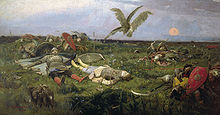1185
Appearance
| Millennium: | 2nd millennium |
|---|---|
| Centuries: | |
| Decades: | |
| Years: |
| 1185 by topic |
|---|
| Leaders |
| Birth and death categories |
| Births – Deaths |
| Establishments and disestablishments categories |
| Establishments – Disestablishments |
| Art and literature |
| 1185 in poetry |
| Gregorian calendar | 1185 MCLXXXV |
| Ab urbe condita | 1938 |
| Armenian calendar | 634 ԹՎ ՈԼԴ |
| Assyrian calendar | 5935 |
| Balinese saka calendar | 1106–1107 |
| Bengali calendar | 592 |
| Berber calendar | 2135 |
| English Regnal year | 31 Hen. 2 – 32 Hen. 2 |
| Buddhist calendar | 1729 |
| Burmese calendar | 547 |
| Byzantine calendar | 6693–6694 |
| Chinese calendar | 甲辰年 (Wood Dragon) 3882 or 3675 — to — 乙巳年 (Wood Snake) 3883 or 3676 |
| Coptic calendar | 901–902 |
| Discordian calendar | 2351 |
| Ethiopian calendar | 1177–1178 |
| Hebrew calendar | 4945–4946 |
| Hindu calendars | |
| - Vikram Samvat | 1241–1242 |
| - Shaka Samvat | 1106–1107 |
| - Kali Yuga | 4285–4286 |
| Holocene calendar | 11185 |
| Igbo calendar | 185–186 |
| Iranian calendar | 563–564 |
| Islamic calendar | 580–581 |
| Japanese calendar | Genryaku 2 / Bunji 1 (文治元年) |
| Javanese calendar | 1092–1093 |
| Julian calendar | 1185 MCLXXXV |
| Korean calendar | 3518 |
| Minguo calendar | 727 before ROC 民前727年 |
| Nanakshahi calendar | −283 |
| Seleucid era | 1496/1497 AG |
| Thai solar calendar | 1727–1728 |
| Tibetan calendar | 阳木龙年 (male Wood-Dragon) 1311 or 930 or 158 — to — 阴木蛇年 (female Wood-Snake) 1312 or 931 or 159 |
Year 1185 (MCLXXXV) was a common year starting on Tuesday (link will display the full calendar) of the Julian calendar.
Events
By area
Africa
- The Almohads reconquer Béjaïa and Algiers, that had been taken by the Banu Ghaniya, descendants of the Almoravids.[1]
Asia
Japan
- April 25 – Genpei War: The naval Battle of Dan-no-ura leads to a Minamoto victory in Japan, and the death of Emperor Antoku.
- The Heian period ends, and the Kamakura period begins, in Japan.
India
- Mohammad of Ghur takes Punjab and Lahore, overthrowing the Ghaznavids.
Europe
British isles
- Henry II of England knights his heir John of England, and sends him to Ireland to enforce English control. According to Gerald of Wales, the only witness to chronicle the expedition, it is a disaster in which money is wasted on alcohol, and the Irish chieftains are scorned into uniting against a common enemy. By the end of the year, John has returned to England in defeat. Nonetheless, Henry gets him named King of Ireland by Pope Urban III, and procures a golden crown with peacock feathers.[2]
- Templars settle in London and begin building the New Temple Church.
Eastern Europe
- August 15 – The cave city of Vardzia is consecrated. by Queen Tamar of Georgia.
- August 24 – the Byzantine city of Thessalonica is sacked, by the Norman Sicilian troops.[3]
- September 11–12 – Isaac II Angelos leads a revolt in the Byzantine Empire, which deposes Andronikos I Komnenos and ends the Komnenos Dynasty.
- November 7 – Battle of Demetritzes: Byzantine general Alexios Branas decisively defeats the Normans, ending their invasion of the Byzantine Empire.
- Peter and John Asen lead a revolt of the Vlachs and Bulgars against the Byzantine Empire, eventually establishing the Second Bulgarian Empire.

- Igor Svyatoslavich's failed campaign against the Cumans, later immortalized in The Tale of Igor's Campaign, takes place this year.
By topic
Astronomy
- May 1 – The Solar eclipse of 1 May 1185, visible across Central America, Northern and Eastern Europe and Kazakhstan, occurs.
Markets
- Evidence is first uncovered, that the king of England is using the safes of the New Temple in London, under the guard of the Knights Templar, to store part of his treasure.[4]
Religion
- November 25 – Pope Urban III succeeds Pope Lucius III, as the 172nd pope.
Births
- April 23 – King Afonso II of Portugal (d. 1223)
- Gertrude of Merania, queen consort of Hungary (d. 1213)
- Inge II of Norway (d. 1217)
- Robert III, Count of Dreux (d. 1234)
Deaths
- March 16 – Baldwin IV of Jerusalem (b. 1161)
- April 25 – Emperor Antoku of Japan (b. 1178)
- June 16 – Richeza of Poland, Queen of Castile (b. c. 1140)
- June 19 – Taira no Munemori, Japanese soldier (b. 1147)
- July 18 – Stefan, first Archbishop of Uppsala (b. before 1143)
- September 11 – Stephen Hagiochristophorites, chief minister of the Byzantine Empire (b. c. 1130)
- September 12 – Andronikos I Komnenos, Byzantine Emperor (b. c. 1118)
- November 25 – Pope Lucius III (b. 1097)
- December 6 – King Afonso I of Portugal (b. 1109)
- Gillchreest MacCathmhaoil, Irish Head Chieftain of Cineal Fereadaidh, clan Aongus, clan Dubhinreacht, clan Fogarty O'Ceannfhoda, and clan Colla
- Taira no Noritsune, Japanese soldier (b. 1160)
- Taira no Shigehira, Japanese soldier (b. 1158)
- Taira no Tomomori, Japanese soldier (b. 1152)
- Ibn Tufail, Arab philosopher, physician, and courtier (b. c. 1105)
References
- ^ Picard, Christophe (1997). La mer et les musulmans d'Occident VIIIe-XIIIe siècle. Paris: Presses Universitaires de France.
- ^ King John by Warren. University of California Press, 1961. p. 35
- ^ Abels, Richard Philip; Bernard S. Bachrach (2001). The Normans and their adversaries at war. Woodbridge: Boydell & Brewer. p. 100. ISBN 0-85115-847-1.
- ^ Ferris, Eleanor (1902). "The Financial Relations of the Knights Templars to the English Crown". American Historical Review. 8 (1).
